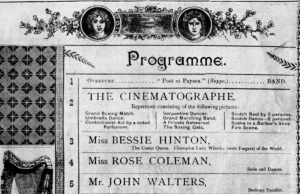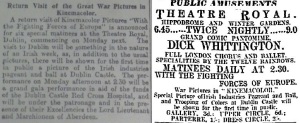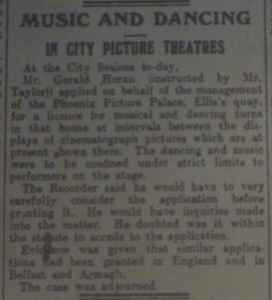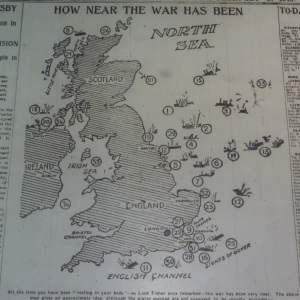Denis Condon’s blog Early Irish Cinema looks back at the early development of cinema in Ireland on the anniversaries of those developments and offers information on what cinemagoers could have seen in Irish cinemas a century ago. Here Denis explores how picture houses offered a variety of attractions in their programme.
Unlike the experience in an Irish picture house in 2015, the cinema audience a century ago expected to share the auditorium not only with other spectators but also the musicians and – often – variety artistes who were responsible for producing a considerable part of the entertainment live. On 4 February 1915, the Ulster correspondent of the cinema trade journal Bioscope began his/her regular “Jottings from Ulster” column in fairly typical fashion by praising the attractions available at Provincial Cinematograph Theatres’ Picture House, Royal Avenue, Belfast. The attractions included the pictures Marguerite of Navarre (France: Pathé, 1914), Nick Winter in the Wild West (US: Eclectic, 1914) and The Bond of Love (US: Selig, 1914), which were accompanied by an “orchestra [that] has been considerably augmented.” The music produced by the musicians in the cinema was not the only part of the show produced live because “the monotony of all pictures is delightfully relieved by Mr. Norman Williams, who sings every afternoon and evening.” While the orchestra was expected to accompany the pictures and increase their attractiveness by augmenting them, Williams’ singing was a separate feature of the programme and was used – according to Jottings, at least – to ensure that audiences would not be bored by a programme that just consisted of films.
 Part of the programme at Dublin’s Star Theatre of Varieties at which the first films in Ireland were shown in April 1896.
Part of the programme at Dublin’s Star Theatre of Varieties at which the first films in Ireland were shown in April 1896.
The claim here is worth lingering on because it implies that variety was a necessary part of the programme, and in this case, the necessary variety was based on the differences between live and recorded performance. Variation in the length and genre of films has already been discussed in other posts, but here variety refers to the kinds of live performance – singing, dancing, comedy, juggling, acrobatics and animal acts –with which audiences a century ago would have been intimately familiar from the variety theatre. The variety theatre or music hall had been one of the first places at which moving pictures were exhibited, and the notion that popular entertainment should offer a variety of attractions persisted long after dedicated picture houses first appeared, which in Ireland was the late 1900s. In the 1890s and 1900s, variety theatre had added film as another of its acts or “turns,” and in the 1910s and for a long time thereafter, some picture houses included not only a variety of film attractions with musical accompaniment but also live variety acts. In fact, given the existence of the mix of film and variety entertainment at such large venues as Dublin’s 4,000-seat Theatre Royal until the 1960s that cine-variety should be considered one of the country’s most persistent forms of entertainment.
The film sound technologies on exhibition in Ireland in early 1915 suggested that lecturer and orchestra could be dispensed with. In late January, the Edison company’s Kinetophone talking pictures, which had had their first Irish appeared in Belfast the previous March, opened for a two-week run at Dublin’s Bohemian Picture Theatre. “The success of this latest addition to the attractions of the popular Phibsboro’ House,” observed the reviewer in the Evening Telegraph, “was from the start most marked, and the display, which last night included a musical sketch entitled ‘After College Days’ and Edison’s Minstrels, immediately appealed to the hearty enthusiasm of the very large audience” (“The Bohemian”). However, the Kinetophone items did not even nearly fill the programme but had to be supplemented by three reels of The Barefoot Boy (US: Kalem, 1914), the Pathé Gazette newsreel and comedy The Great Toe Mystery (US: Keystone, 1914). And the Kinetophone was not even new. When the earliest dedicated picture houses opened in Ireland in the late 1900s, the Filmophone Talking and Singing Pictures was just one of the dialogue-and-music systems that these early venues periodically exhibited. However, in 1915, a full programme of talking-and-singing pictures was still some way off.
Nevertheless, Jottings pointed out that “[v]arieties are very steadily creeping into the motion houses throughout Ulster to-day” (“Jottings,” 28 Jan.). At the end of January, Norman Williams at the Picture House, Royal Avenue was joined by “Miss Ruth Vollmer, Scotch comedienne, dancer and clever exponent on the Scotch pipes, [who] was the star attraction at Lisburn Palace” (ibid.). However, once Charles Bronson took over management of the Palace, Omagh, he relied on exclusive films to draw the audience rather than the variety turns favoured by former manager Alex Cockle (ibid.). At the end of February, Jeanne Bal and Eugenie Van Camp – “two Belgian refugees” – appeared at the Picture House, Regent Street, Newtownards, where the “rendition by Mdlle. Van Camp of ‘Tipperary’ is very pleasing” (“Jottings,” 4 Mar.). The other Newtownards cinema, the Picture Palace, had four variety acts, so that “one would not know whether to refer to it as a cinema with varieties, or as a music-hall with pictures” (ibid.).
 Kinemacolor exhibition at Dublin’s Theatre Royal; Irish Times 9 Feb. 1915: 4
Kinemacolor exhibition at Dublin’s Theatre Royal; Irish Times 9 Feb. 1915: 4
While the inclusion of variety acts in a picture house programme appeared to put more emphasis on the live aspects of cinema and the associated possibilities for local variation, the appearance in Ireland in early 1915 of technological developments in film sound and colour suggested that a complete cinematic experience could be supplied by the recorded artefact alone. Colour film technology was to be seen from 8-13 February at the matinees of Dublin’s Theatre Royal, which hosted a return of the Kinemacolor war films The Fighting Forces of Europe, which had been first seen in Ireland the previous November. The return visit came with the added publicity of royal command performances in London, and the first show in Dublin was attended by the Lord Lieutenant and Lady Aberdeen. The Aberdeens would themselves leave Ireland in late February, and their departure was filmed by Pathé and by local exhibitor I. I. Bradlaw and local topical specialist Norman Whitten (Paddy, 25 Feb.). In any case, the Kinemacolor war films were one kind of technological development of cinema but they were not self-explanatory and so needed to be “fully described by an interesting lecture given by Mr. John Doran, and a special orchestra under the direction of Mr. Allan Blackwood, the well-known conductor” (“War Pictures”).
 Edison’s Kinetophone 1914-15. Irish News 23 Mar. 1914: 8 and Evening Telegraph 25 Jan. 1915: 3.
Edison’s Kinetophone 1914-15. Irish News 23 Mar. 1914: 8 and Evening Telegraph 25 Jan. 1915: 3.
The film sound technologies on exhibition in Ireland in early 1915 offered the possibility that lecturer and orchestra could be dispensed with. In late January, the Edison company’s Kinetophone talking pictures, which had had their first Irish appeared in Belfast the previous March, opened for at two week run at Dublin’s Bohemian Picture Theatre. “The success of this the latest addition to the attractions of the popular Phibsboro’ House,” observed the reviewer in the Evening Telegraph, “was from the start most marked, and the display, which last night included a musical sketch entitled ‘After College Days’ and Edison’s Minstrels, immediately appealed to the hearty enthusiasm of the very large audience” (“The Bohemian”). However, the Kinetophone items did not even nearly fill the programme but had to be supplemented by three reels of The Barefoot Boy (US: Kalem, 1914), the Pathé Gazette newsreel and comedy The Great Toe Mystery (US: Keystone, 1914). A full programme of talking-and-singing pictures was still some way off.
 Evening Telegraph 19 Oct. 1914: 4
Evening Telegraph 19 Oct. 1914: 4
Licensing was one reason that picture house owners might have wished to have fewer live elements to deal with. Live music, and particularly the live singing of a variety artist, required entertainment venues to have a music-and-dancing licence. The reasons for this were made clear in late February 1915, when the latest proceedings were heard against a Dublin picture house, in this case, the Dame Street Picture House, that the city authorities claimed needed not just a cinematograph licence – which was mainly designed to ensure fire safety – but also a music-and-dancing licence. A related case against the Electric Theatre, Talbot Street had concluded in December 1914 with the prosecution of that cinema for not having a music-and-dancing licence (“City Cinemas”). The case against the Electric Theatre was apparently more straightforward because at the Electric’s evening performances, the pictures were accompanied not only by the piano that was used earlier in the day but also by a violin and cello. As a result, Justice Mahony had decided that the Electric’s claim that music was subsidiary to the entertainment was not sustainable. Although the case against the Dame was also due for decision, it had been adjourned because at the Dame only a piano was used to accompany the films.
These cases offer some fascinating details about the nature of live musical accompaniment at these relatively small picture houses at this period. Neither of them employed variety acts, and the musical accompaniment was the main kind of live supplement to the recorded images. While such larger picture houses as the Rotunda and Bohemian made a feature of the live music they offered, naming the musical director in advertising and at least on occasion, mounting special musical entertainments, these smaller venues downplayed the role of music to their entertainment. At least they did so in the context of this court case, which was part of a legal strategy to avoid having to pay for a music licence and/or pay a fine. The Electric’s argument that music was subsidiary was judged unbelievable because the judge concluded that the music was not just used to cover incidental noises in the cinema. Although the newspaper accounts do not state this explicitly, this was clearly true because the Electric augmented the music at the evening entertainment by the inclusion not just of louder music to cover the increased noises of a larger audience but of two instruments that enhanced the musical range of the performance.
By providing consistent piano accompaniment day and evening, the Dame had a stronger case that the music was subsidiary. As a result, when on 27 January 1915, the magistrate also fined them for not having a music licence, they appealed to the King’s Bench, which heard the case on 25 February. “It was proved,” a report in the Dublin Evening Mail revealed, “that at the exhibitions of pictures music in the form of piano playing was performed, which was more or less appropriate to the picture at the time on the screen Such music was performed only while the pictures were on the screen.” As a result, the Dame argued that a
certain amount of noise was occasioned during the exhibition of the pictures by the coming and going of attendants and persons entering and leaving the premises, and by the working of the [projection] apparatus. […M]usic was necessary, and was intended mainly for the purpose of deadening or drowning the noise which was likely to distract attention from the pictures, and that under these circumstances a licence for music was not necessary (“Music in a Cinema”)
This offers a vivid image of the kind of challenges picture-house musicians faced. It did not, however, convince the justices on the King’s Bench, who voted a 2-1 majority to affirm the magistrate’s decision that the music at the Dame represented a separate attraction that required a licence. Even if part of the function of music in the picture house was to “drown the noise” of early cinema’s supplementary live soundtracks, it also provided an aesthetic experience in itself, if not a layer of acoustic interpretation of the pictures on screen.
War-themed subjects remained among the most popular of the pictures on screen. How films provided an alternative forum in which to think about current events was shown when the Evening Herald printed a map of the war at sea around the coasts of Britain and Ireland, emphasizing the proximity of the war. Although much of this action was located in the North Sea, German submarines attempted to cut the transatlantic supply lines to Britain. The Lusitania – sunk off Cork in May 1915 – was the most famous casualty of the German blockade. With the appearance of The Huns of the North Sea in Ireland at the end of January, Sidney Morgan and John Payne’s P&M’s Films offered Irish audiences a way of imagining the new forms of warfare at sea involving minefields and submarines. The ‘’short two-reeler, dealing with the mine-laying […] should prove exceptionally attractive to halls situated in the North of Ireland, where the mine-field was lately found (Paddy, 21 Jan.).
Whether through live music or engaging and relevant images, the cinema a century ago continued to draw the attention of the public.
Denis Condon lectures in film at NUI Maynooth.
Contact: denis.j.condon@nuim.ie
References
“The All-Picture Programme: Where “Variety” Is Not Wanted.” Bioscope 21 Sep. 1911: 591.
“The Bohemian.” Evening Telegraph 26 Jan. 1915: 2.
“City Cinemas: Question of Music Licence: Prosecution: In the Dublin Police Courts; Mr. Mahony’s Decision.” Evening Herald 30 Dec. 1914: 3.
“Dancing and Singing: City Picture House’s Application: Described as ‘Novel.’” Evening Herald 23 Oct. 1914: 4.
“Jottings from Ulster.” Bioscope 28 Jan. 1915: 339; 4 Feb. 1915: 437; 4 Mar. 1915: 837.
“Music in a Cinema: Interesting Dublin Case: ‘To Drown the Noise.’”Dublin Evening Mail 26 Feb. 1915: 5.
Paddy. “Pictures in Ireland.” Bioscope 21 Jan. 1915: 263; 25 Feb. 1915: 741.
“Theatre Royal Hippodrome.” Evening Herald 6 Feb. 1915: 6.
“Variety Artistes in Picture Theatres.” Bioscope 19 Nov. 1914: 707.
“Variety Turns in Picture Theatres.” Bioscope 17 Dec. 1914: 1288.
“War Pictures in Kinemacolor.” Dublin Evening Mail 4 Feb. 1915: 6.






1 Comment
We have no variety in 2015! All Irish cinemas show now are the exact same movies as each other.